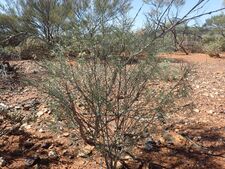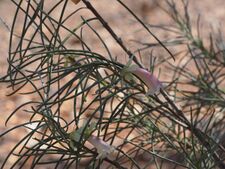Biology:Eremophila oppositifolia
| Weeooka | |
|---|---|

| |
| Subspecies angustifolia near Wongan Hills | |
| Scientific classification | |
| Kingdom: | Plantae |
| Clade: | Tracheophytes |
| Clade: | Angiosperms |
| Clade: | Eudicots |
| Clade: | Asterids |
| Order: | Lamiales |
| Family: | Scrophulariaceae |
| Genus: | Eremophila |
| Species: | E. oppositifolia
|
| Binomial name | |
| Eremophila oppositifolia | |
| Synonyms[1] | |
| |
Eremophila oppositifolia, commonly known as weeooka, twin-leaf emu bush and mountain sandalwood,[2] is a plant in the figwort family, Scrophulariaceae, and is endemic to Australia . It is a shrub or small tree with its leaves arranged in opposite pairs and has cream to red or sometimes maroon coloured flowers. It occurs in all mainland states, but not the Northern Territory.
Description
Eremophila oppositifolia is a shrub or small tree which grows to a height of 1–5 metres (3–20 ft), sometimes to 10 metres (30 ft). Its branches, leaves and flower stalks are covered with a layer of fine hairs pressed against the surface. The branches are rough due to persistent leaf bases and sometimes become glabrous with age. The leaves are arranged in opposite pairs along the branches and are linear to almost cylindrical in shape and often have a hooked end. They are 29–120 millimetres (1–5 in) long, 0.9–7 millimetres (0.04–0.3 in) wide, covered with fine hairs pressed against the surface and the young leaves also have yellowish glandular hairs on the lower surface.[2][3][4][5][6]
The flowers are borne singly or in groups of up to 4 in leaf axils on hairy stalks 3–10.5 mm (0.1–0.4 in) long. There are 5 hairy, spoon-shaped to lance-shaped sepals which are mostly 7–18 mm (0.3–0.7 in) long and which are cream-coloured or brown. The petals are mostly 20–30 mm (0.8–1 in) long and are joined at their lower end to form a tube. The petal tube is cream-coloured with a pink tinge, pink, red or (rarely) maroon. The tube and its lobes are glabrous apart from the margins of the lobes, and the inside of the tube which is hairy. The 4 stamens extend slightly beyond the end of the petal tube. Flowering occurs from winter to early summer[3] and the fruits which follow are oval to cylindrical in shape and 4–7 mm (0.2–0.3 in) long.[2][3][4][5]
Taxonomy and naming
The first formal description of this species was published by botanist Robert Brown in 1810 in Prodromus florae Novae Hollandiae.[7][8] The specific epithet (oppositifolia) is derived from the Latin words oppositus meaning "on the other side" or "contrary"[9]:73 and folia meaning "leaves".[9]:94
The names of three subspecies are accepted by the Australian Plant Census:
- Eremophila oppositifolia R.Br. subsp. oppositifolia[10] has leaves that are almost cylindrical in shape, often flattened or channelled on the lower surface and 1–3 mm (0.04–0.1 in) wide;[2]
- Eremophila oppositifolia subsp. angustifolia (S.Moore) Chinnock [11] has leaves that are cylindrical in shape, not flat, firm, erect and 1–3 mm (0.04–0.1 in) wide;[2]
- Eremophila oppositifolia subsp. rubra (C.T.White & W.D.Francis) Chinnock [12] has leaves that are flat and 3–7 mm (0.1–0.3 in) wide.[2]
Distribution
Subspecies oppositifolia is widespread and common from the Eyre Peninsula and Gawler Ranges in South Australia eastwards to south-western New South Wales and north-western Victoria in clay-loam in woodland and shrubland. Subspecies angustifolia is widespread and common in Western Australia and in isolated locations in South Australia, growing in a range of soils in mulga and Eucalyptus woodland. Subspecies rubra is found from western Queensland to western and central New South Wales west of Condobolin, usually growing in woodland.[2][3]
Use in horticulture
This large eremophila has attractive foliage and the colourful sepals extend its flowering period. It is a good feature plant but can also be used as a windbreak or screening plant. Propagation from cuttings is easy and the shrub will grow in a wide range of soils, including clay in either full sun or partial shade. It will tolerate long droughts but occasional watering will help to ensure a good flowering season. Light frosts are tolerated without damage but heavy frosts may cause the loss of leaves.[13][14]
Conservation
Weeooka is classified as "not threatened" by the Western Australian Government Department of Parks and Wildlife.[15]
References
- ↑ 1.0 1.1 "Eremophila oppositifolia". Australian Plant Census. https://biodiversity.org.au/nsl/services/apc-format/display/114575. Retrieved 6 September 2020.
- ↑ 2.0 2.1 2.2 2.3 2.4 2.5 2.6 Chinnock, R.J. (Bob) (2007). Eremophila and allied genera : a monograph of the plant family Myoporaceae (1st ed.). Dural, NSW: Rosenberg. pp. 412–417. ISBN 9781877058165.
- ↑ 3.0 3.1 3.2 3.3 Chinnock, Robert J.. "Eremophila oppositifolia". Royal Botanic Gardens Sydney: PlantNET. http://plantnet.rbgsyd.nsw.gov.au/cgi-bin/NSWfl.pl?page=nswfl&lvl=sp&name=Eremophila~oppositifolia. Retrieved 23 February 2016.
- ↑ 4.0 4.1 "Eremophila oppositifolia". State Herbarium of South Australia:eflora. http://www.flora.sa.gov.au/cgi-bin/speciesfacts_display.cgi?form=speciesfacts&family=&genus=Eremophila&species=oppositifolia&iname=&submit=Display. Retrieved 23 February 2016.
- ↑ 5.0 5.1 "Eremophila oppositifolia". Lucid Keys. http://keys.lucidcentral.org/keys/v3/scotia/key/Plants%20and%20Fungi%20of%20south%20western%20NSW/Media/Html/Eremophila_oppositifolia.htm. Retrieved 23 February 2016.
- ↑ Brown, Andrew; Buirchell, Bevan (2011). A field guide to the eremophilas of Western Australia (1st ed.). Hamilton Hill, W.A.: Simon Nevill Publications. p. 198. ISBN 9780980348156.
- ↑ "Eremophila oppositifolia". APNI. http://id.biodiversity.org.au/name/apni/114575. Retrieved 23 February 2016.
- ↑ Brown, Robert (1810). Prodromus florae Novae Hollandiae. London. p. 518. https://www.biodiversitylibrary.org/item/21871#page/386/mode/1up. Retrieved 24 February 2016.
- ↑ 9.0 9.1 Brown, Roland Wilbur (1956). The Composition of Scientific Words. Washington, D.C.: Smithsonian Institution Press.
- ↑ "Eremophila oppositifolia". Australian Plant Census. https://biodiversity.org.au/nsl/services/apc-format/display/207786. Retrieved 6 September 2020.
- ↑ "Eremophila oppositifolia". Australian Plant Census. https://biodiversity.org.au/nsl/services/apc-format/display/207537. Retrieved 6 September 2020.
- ↑ "Eremophila oppositifolia". Australian Plant Census. https://biodiversity.org.au/nsl/services/apc-format/display/117903. Retrieved 6 September 2020.
- ↑ Boschen, Norma; Goods, Maree; Wait, Russell (2008). Australia's eremophilas : changing gardens for a changing climate. Melbourne: Bloomings Books. pp. 53–54. ISBN 9781876473655.
- ↑ Wrigley, John W.; Fagg, Murray (1983). Australian native plants : a manual for their propagation, cultivation and use in landscaping (2nd ed.). Sydney: Collins. ISBN 0002165759.
- ↑ "Eremophila oppositifolia". FloraBase. Western Australian Government Department of Parks and Wildlife. https://florabase.dpaw.wa.gov.au/browse/profile/7247.
Wikidata ☰ Q3609077 entry
 |




